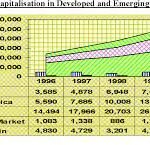What’s algorithmic trading?
Algorithmic trading( also called automated trading, black-box trading, or algo trading) uses a computer program that follows a defined set of instructions( an algorithm) to close a trade. A trade can theoretically induce gains at pets and frequentness that are insolvable for a mortal dealer.
Defined instruction sets are grounded on timing, price, volume, or any fine model. In addition to the profitable openings for the dealer, algo-trading makes requests more liquid and trading more methodical by barring the impact of mortal feelings on trading conditioning.
Algorithmic trading combines computer programming and fiscal requests to execute trades at precise moments.
Algorithmic trading attempts to take the emotion out of trades, ensure the most effective trade prosecution, place orders incontinently, and reduce trading freights.
Algo- Trading Time Scale
important of moment’s algo- trading is high-frequency trading( HFT), which seeks to benefit by placing large figures of orders at fast pets in multiple requests and with multiple decision parameters grounded on pre-programmed instructions.
Algo-trading is used in numerous forms of trading and investment conditioning, including
Medium- to long-term investors or buy-side enterprises — pension finances, collective finances, insurance companies — use algo-trading to buy stocks in bulk when they do not want to impact stock prices with separate, large-volume investments.
Short-term dealers and vend-side actors – request makers( similar to brokerage houses), bookmakers, and arbitrageurs – benefit from automated trade prosecution; also, algo-trading helps in creating enough liquidity for merchandisers in the request.
Methodical dealers — trend followers, barricade finances, or dyads dealers( a request-neutral trading strategy that combines a long position with a short position in a brace of largely correlated instruments, similar to two stocks, exchange-traded finances( ETFs), or currencies) — you’ll find that much more effective to program their trading rules and let the program trade automatically.
- Algorithmic trading provides a more methodical approach to active trading than styles grounded on a dealer’s suspicion or instinct.
- Common trading strategies include trend-following strategies, arbitrage openings, and indicator fund rebalancing.
- Algorithmic trading is also done grounded on trading volume(volume-laden average price) or the passage of time(time-laden average price).
- To get started with algorithmic trading, you need access to a computer, network access, fiscal request knowledge, and rendering chops.
How algorithmic trading works
Buy 50 shares of a stock when its 50-day moving average crosses the 200-day moving normal. ( A moving normal is a normal of once data points that smooths out diurnal price oscillations and therefore identifies trends.)
Sell shares of a stock when its 50-day moving average falls below its 200-day moving normal.
Using these two simple instructions, the computer program will automatically track the stock price( and moving average pointers) and enter buy and vend orders when defined conditions are met. The dealer no longer has to cover current prices and maps or enter orders manually. An algorithmic trading system does this automatically by rightly relating the trading occasion.
Advantages and disadvantages of algorithmic trading
- Advantages
Algo-trading provides the following benefits - Stylish prosecution Trades are frequently executed at the most stylish possible prices.
- Low quiescence Trade order entry is instant and accurate( there is a high chance of prosecution in asked situations). Trades are timed correctly and incontinently to avoid significant price changes.
- Reduced sale costs.
- contemporaneous automatic checks of multiple request conditions.
- No mortal Error Reduced threat of primer or trade entry crimes. It also negates mortal merchandisers; tendency to be told by emotional and cerebral factors.
- Backtesting Algo trading can be backtested using available literal and real-time data to see if it’s a feasible trading strategy.
- Disadvantages
There are also several downsides or downsides to algorithmic trading to consider - quiescence Algorithmic trading relies on high prosecution speed and low quiescence, which is the detention in executing a trade. However, it can result in missed openings or losses, If the trade isn’t executed snappily enough.
- Black Swan Events Algorithmic trading relies on literal data and fine models to prognosticate unborn request movements. still, unlooked-for request dislocations, known as black swan events, can do, which can affect losses for algorithmic dealers.
- Dependence on Technology Algorithmic trading depends on technology, including computer programs and high- speed Connections. However, it can disrupt the trading process and lead to losses, If there are specialized problems or failures.
- request Impact Large algorithmic trades can have a significant impact on request prices, which can lead to losses for dealers who are unable to acclimate their trades in response to these changes. Algo trading has also been suspected of adding request volatility at times, indeed leading to so-called flash crashes.
- Regulation Algorithmic trading is subject to colorful nonsupervisory conditions and oversight, compliance with which can be complex and time-consuming.
- High capital costs Developing and enforcing algorithmic trading systems can be precious, and dealers may have to pay ongoing freights for software and data coffers.
- Limited Customization Algorithmic trading systems are grounded on pre-defined rules and guidelines, which may limit dealers’ capability to customize their trades to suit their specific requirements or preferences.
- Lack of mortal judgment Algorithmic trading relies on fine models and literal data, which means it doesn’t take into account private and qualitative factors that can affect request movements. This lack of mortal judgment can be a disadvantage for dealers who prefer a further intuitive or spontaneous approach to trading.
Algorithmic trading combines computer software and fiscal requests to open and close trades grounded on programmed law. Investors and dealers can set when they want to open or close trades. They can also use calculating power to perform high- frequency trading. Due to the variety of strategies that dealers can use, algorithmic trading is current in the fiscal requests moment. To get started, prepare computer tackle, programming chops, and fiscal request experience.
Image Source: Investopedia
Also Read: The Four Most Important Factors Affecting the Gold Rate




